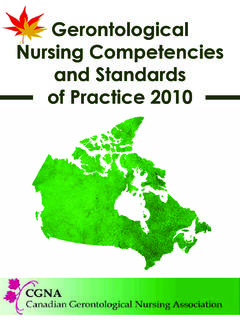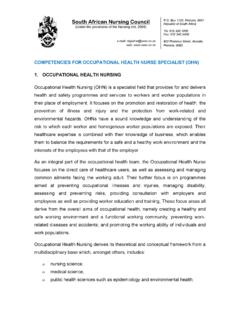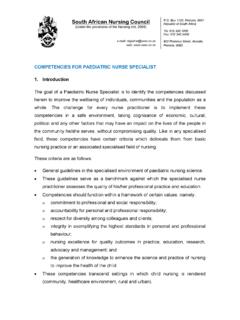Transcription of OLDER ADULTS - WGEC
1 OLDER ADULTS : RECOMMENDED. BACCALAUREATE competencies . AND. CURRICULAR GUIDELINES. FO R. GERIATRIC nursing CARE. July 2000. Division of nursing , School of Education, New York University 246 Greene Street, New York, NY 10003-6677. Tel: 212-998-9018 Fax: 212-995-4770. email: July 2000. The American Association of Colleges of nursing and the John A. Hartford Foundation Institute for Geriatric nursing have worked in collaboration to develop these competencies and curricular guidelines for geriatric nursing care. As the percentage of the elderly population continues to increase dramatically, the demand for geriatric nursing care also is rising. AACN and the Hartford Institute have developed core competencies for baccalaureate nursing education to ensure that nursing students will be able to provide the necessary geriatric care for the nation's aging population. Although the majority of baccalaureate prepared nurses provide care for geriatric patients, most receive limited preparation in the baccalaureate nursing curriculum.
2 It is our hope that this document will provide the necessary information and guidance to assist nurse educators in incorporating geriatric nursing content into the curriculum. Sincerely, Carolyn Williams, PhD, RN, FAAN. President, AACN. Mathy Mezey, RN, EdD, FAAN. Director, Hartford Institute ACKNOWLEDGMENTS. The John A. Hartford Foundation American Association of Colleges Institute for Geriatric nursing of nursing Mathy Mezey, RN, EdD, FAAN Joan Stanley, PhD, RN, CRNP. Director Project Director Terry Fulmer, RN, PhD, FAAN Geraldine D. Bednash, PhD, RN, FAAN. Co-Director Executive Director AACN and the Hartford Institute are grateful to the following individuals for serving on the National Expert Panel for Baccalaureate competencies in Geriatric nursing : Patricia M. Burbank, DNSc, RN. Professor, University of Rhode Island Mary T. Champagne, PhD, RN. Dean, Duke University School of nursing Barbara Conrad, PhD, RN.
3 Director and Associate Professor, University of Arkansas School of nursing Ellen Flaherty, PhD(c), RN. GITT Project Director, New York University Division of nursing Evelynn C. Gioiella, PhD, RN, FAAN. Dean, Hunter College of CUNY Schools of the Health Professions Sherry A. Greenberg, MSN, RN, CS, GNP. Coordinator, Advanced Practice nursing , Geriatrics Program New York University Division of nursing Hurdis M. Griffith, PhD, RN, FAAN. Dean and Professor, Rutgers, The State University of New Jersey College of nursing Norma Rodgers-Hunter President, New Jersey nursing Students, Inc. Sarah H. Kagan, PhD, RN, CS, AOCN. Assistant Professor of Gerontological nursing , University of Pennsylvania School of nursing Carl Kirton, RN, MA, ACRN, ANP, CS. Faculty, New York University Division of nursing Carla Mariano, RN, Med, EdD. Associate Professor, New York University Division of nursing Charlene Quinn, PhD, RN.
4 Post-doctoral Fellow, University of Maryland Department of Epidemiology and Preventative Medicine Fay Raines, PhD. Dean, University of Alabama, Huntsville, School of nursing Coralease Ruff, PhD. Dean, Howard University Division of nursing Lynne Seymour, RN, MNSC. Faculty, University of Arkansas, Fayetteville, School of nursing Dina Shah, BSN, RN. Registered Nurse, Mount Sinai-NYU Medical Center/Health System Raelene Shippee-Rice, PhD. Chairperson & Associate Director, University of New Hampshire Department of nursing Eugenia L. Siegler, MD. Associate Professor of Clinical Medicine, Weill Medical College of Cornell University Clinical Associate Professor of nursing , New York University W. June Simmons, MSW, LCSW. President and CEO, Partners in Care Foundation Regina P. Smith, MSN, CS. Assistant Professor, Minnesota State University, Mankato Shirlee Ann Stokes, EdD, RN, FAAN. Professor, Pace University Elizabeth Tanner, PhD, RN.
5 Associate Professor, University of Alabama, Huntsville, School of nursing Dianne Thames, DNS, RNC, APRN. Associate Professor, National Gerontological nursing Association Maria L. Vezina, EdD, RN. Director, nursing Education and Recruitment, The Mount Sinai Hospital in New York Christine N. Zarb, BSN, RN. Nurse Consultant, VNS Choice, Visiting Nurse Service of New York Staff Support: John A. Hartford Foundation Institute for Geriatric nursing Elaine Gould, MSW, Director for Programs Kiersten Konikowski, BSN(c) Administrative Aide American Association of Colleges of nursing William O'Connor, Director of Publications Emily Schmid, Education Policy and Programming Assistant Background OLDER people constitute a majority - and growing - proportion of people who receive nursing care in the United States. Currently 13% of the nation's population, over 25 million people, are over 65 years of age. This represents an eight-fold increase in the last 80 years, triple that of the population as a whole.
6 By the year 2030, 20 percent of people will be over 65; close to 10. percent of the population will be over 80 years of age (AOA, 1998). The health status of OLDER people is diverse. Health status often is influenced by income level, living arrangements, and need for physical and psycho/social supports. Many of the ailments afflicting the elderly are represented in the 22 priority areas identified as responsive to health promotion and prevention activities in Healthy People 2010: National Health Promotion and Disease Prevention Objectives (PHS, 1999). A major focus of health promotion is to minimize the loss of independence associated with functional decline and illness (Rowe & Kahn, 1999). The predominant health problems of OLDER people are chronic rather than acute and are exacerbated by the normal changes of aging and the increased risk of illness associated with old age. Despite this picture, the majority of OLDER people report themselves to be in "good" health as measured by level of function and general self-perception of health.
7 Of the people who are sick and seek care in this country, the overwhelming majority are elderly. Over 48 percent of hospital patients, 80 percent of home care patients, and 85 percent of all residents of nursing homes are elderly (Mezey, 1996). In home care, the fastest growing area of health care, the 5,600 agencies certified to receive Medicare reimbursement made over 38. million visits to approximately million Medicare beneficiaries. Fifty-two percent of these were nursing visits, while approximately 30 percent were for nursing aide services (Mitty &. Mezey, 1999). Despite a 30-year effort on the part of academic and professional nursing organizations, the number of master's prepared geriatric nurses remains very small. Approximately 1,800 nurses nationally are certified by the American Nurses Credentialing Center (ANCC) as Geriatric Nurse Practitioners, and only 500+ are certified as Gerontological Clinical Nurse Specialists (GCNS).
8 (ANCC, 1999). Their small numbers prevent geriatric nurse specialists from providing care to those OLDER persons who are at high risk or whose needs are extremely complex. In addition, because nurses tend to cluster in urban areas, few advanced practice geriatric nurses are available to care for OLDER persons living in rural areas. With the exception of maternal-child and psychiatric mental-health nursing , the overwhelming majority of nurses practicing in this country today are, by default, geriatric nurses. For this reason, entry-level professional nurses must ensure that OLDER people receive optimum nursing care. Unfortunately, most nurses practicing today have limited preparation in the principles of geriatric nursing care. Only 23 percent of baccalaureate nursing programs have a required course in geriatric nursing (Rosenfeld, Bottrell, Fulmer & Mezey, 1999). The field of geriatrics/gerontology has matured to the point where there is now a recognized body of literature on care of OLDER ADULTS (Abraham, Bottrell, Fulmer & Mezey, 1999).
9 There is now a consensus in geriatric nursing and medicine as to what constitutes best practice in care of OLDER ADULTS . Failure to implement these geriatric care standards for OLDER people is unacceptable. The Association for Gerontology in Higher Education (AGHE), the National League for nursing (NLN), and the Bureau of Health Professions have identified core curriculum and terminal objectives for entry level professional nurses in the area of geriatrics. The proceedings of a conference of geriatric nurse educators funded by Merck and edited by Fulmer & Matzo (1996). provide a critical review of the literature on entry level geriatric nursing education. The authors identify critical competencies that entry level professional nurses need in order to care for OLDER ADULTS and their families. AACN's The Essentials of Baccalaureate Education for Professional nursing Practice (AACN, 1998) provides a framework for developing, defining, and revising baccalaureate nursing curricula.
10 This document addresses the professional values, core competencies , core knowledge, and role of the professional nurse. In addition, the document stresses the need for course work and clinical experiences to prepare the graduate to provide care across the lifespan, with particular attention to changes due to aging. These core values, competencies , and knowledge are vital in ensuring accessible, quality nursing care for the growing geriatric population. Thus, an increasing focus of professional nursing education and practice is on the care of healthy and frail OLDER ADULTS . The purpose of this current document, OLDER ADULTS : Recommended Baccalaureate competencies and Curricular Guidelines for Geriatric nursing Care, is to help nurse educators to incorporate specific geriatric nursing content into baccalaureate nursing curriculum. This baccalaureate geriatric nursing competency document is organized as follows: A) competencies necessary for nurses to provide high-quality care to OLDER ADULTS and their families B) Geriatric competencies in relationship to the AACN document The Essentials of Baccalaureate Education for Professional nursing Practice (AACN, 1998), with suggestions for content and teaching strategies C) Including competencies , content, and teaching strategies in the curriculum D) Resources to facilitate implementation of content and teaching strategies A.

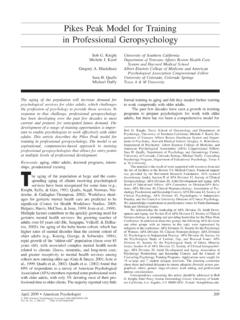
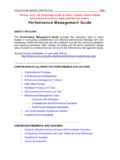


![Community/Public Health Nursing [C/PHN] Competencies …](/cache/preview/d/9/e/8/b/1/0/3/thumb-d9e8b10327128473d9318669ad1a7d65.jpg)
